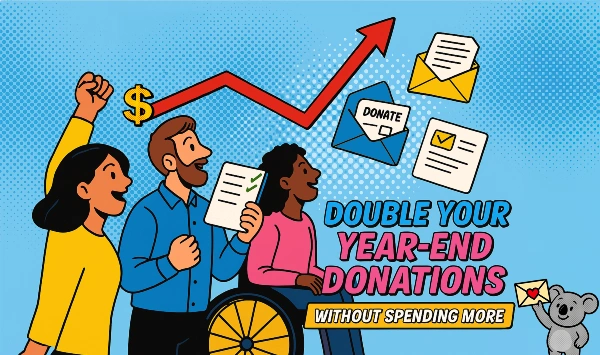Here’s the quick-and-easy way to build an annual communications plan for your fundraising appeals and emails. It’s not a comprehensive strategy, but it will give you a solid to-do list for whatever 12-month period you need.
Step #1: Look at what you did last year
Did the overall plan accomplish what you needed it to accomplish? If it did, congratulations – all the following steps are much easier.
If it fell short, you have some thinking to do, and some hard decisions to make:
Here’s the counterintuitive thing: If last year fell short, don’t cut back and do less! That will just extend your pain into the next year, and might start you on a downward spiral that will be hard to escape – fewer campaigns will not only mean fewer donations, but your donor base will shrink as donors not getting the chance to give lapse – and lapsed donors are difficult to regain!
On the other hand, if last year went well, you may be able to press your advantage and add one or two more campaigns to your plan (see below).
Step #2: Analyze the campaigns
Characterize each appeal on a continuum that ranges from “winner” (meaning you’d be happy to do that well again this year) to “disaster,” (you really can’t take a hit like that again). Of course, most of your appeals will fall somewhere in between. You can clarify your decisions by comparing appeal results to previous years (same time of year and/or similar topics and approaches).
This should give you three basic categories for each appeal in the coming year:
- Strongest campaigns: Don’t reinvent these beautifully round wheels! Do it again, updating as necessary for current conditions. (Though sometimes your very best campaigns really can’t be done again because the situation doesn’t repeat.)
- Weak campaigns: You’re going to have to do some reinventing on these!
- In between: These need some new thinking, but likely not wholesale reinvention.
Step #3: Add campaigns
If your previous year had four or fewer appeals, I can almost guarantee you can improve net revenue by adding an appeal or two. This is probably true even if you had 12 or more appeals, but my guarantee is less confident as that number increases.
If you’re going to add to your schedule, make sure you have the necessary budget to pay for it, and (very important) you have the human capacity to do it without wrecking anyone’s lives. I mean it: fundraising is important, but the wellbeing of your colleagues and you is more important!
If you are going to add appeals to the schedule, aim first for good fundraising times: around holidays your donors celebrate, and in the time leading up to the end of the year. If those times are already taken, just find open spots in the calendar.
In some cases, you may need to reduce appeals, this is where you look into that. Remove your weakest appeals during the more challenging parts of the year.
Step #4: Look for additional ways to improve results
Direct mail appeals are no longer standalone events. You should support campaigns with other channels:
- Email. These days, every direct mail appeal should have between three and ten companion emails, timed to be around and after projected in-home dates of your mail. These emails should have the same message as the mail (almost exactly the same for some of them). A good approach is for the first emails to be longer and most like the direct mail, and for each one to be increasingly short and more urgent.
- Social media. Targeting your donors with the same message is effective for some organizations, but not all. If you haven’t done this before, now is the time to experiment.
- Text-to-give. This is another way to connect with donors that some organizations are finding to be successful.
- Telemarketing. Calling donors during your best campaigns can be a powerful tool. Don’t let your own dislike for getting calls guide your action. Not everyone hates it. And it works.
- Outbound Voicemail. These are pre-recorded calls that go straight to voicemail. The cost per call is low, and it can meaningfully boost response to direct mail and email.
Step #5: Schedule it
For each campaign, start with the mail dates and email blast dates, then work backward through all the steps. Schedule in time for things to go wrong.
That’s a solid plan for your year!
Looking for some quick improvements to your fundraising? Get the Moceanic FREE Guide: 5 Donor Love Tips To Boost Your Fundraising In Hard Times. These are easy, proven tactics that help you connect with donors for more revenue, better retention, and stronger relationships. Click through for your copy today!
Please share your experience by leaving your reply below. We’d love to learn from your experience.












1 Comment. Leave new
Good advice for a functioning nonprofit. My challenge, my organization is in the start-up stage. So far, the best sources for funding is government or government related funding.
I need creative ideas to counter that “I’ll give when you get your charitable status number..” I’ve set up a donation sheet on our website. It’s with an organization that accepts donations on behalf of non-profits without charitable status. The challenge is that they ask the donor to pay the admin. fees starting at 15%. One of my board members almost went berserk! I’ve checked with CanadaHelps, their highest fee is less than 6%. I’ve let my service provider know this. They don’t accept donations from non-profits without a charitable tax no.